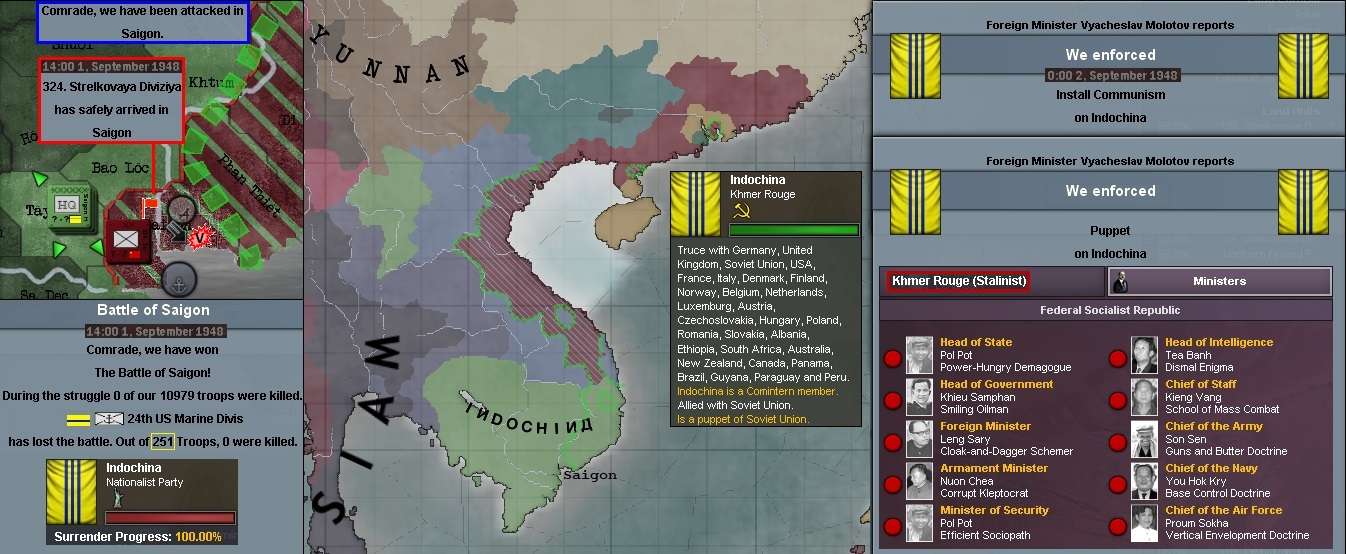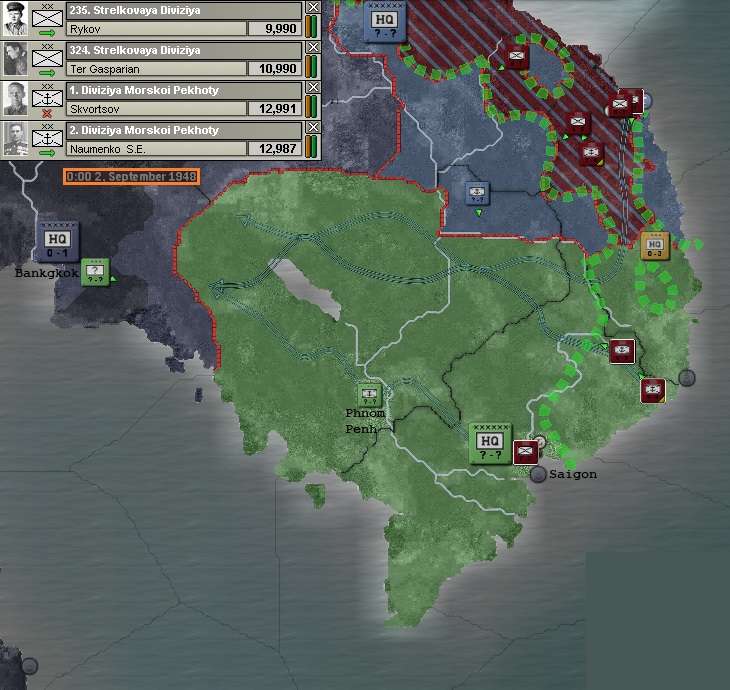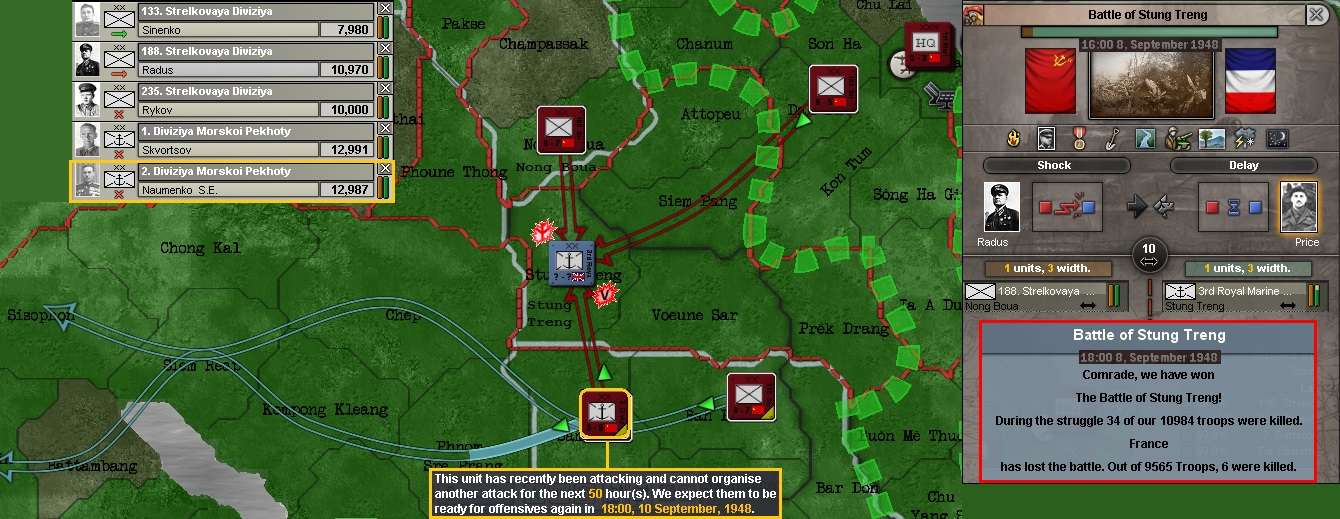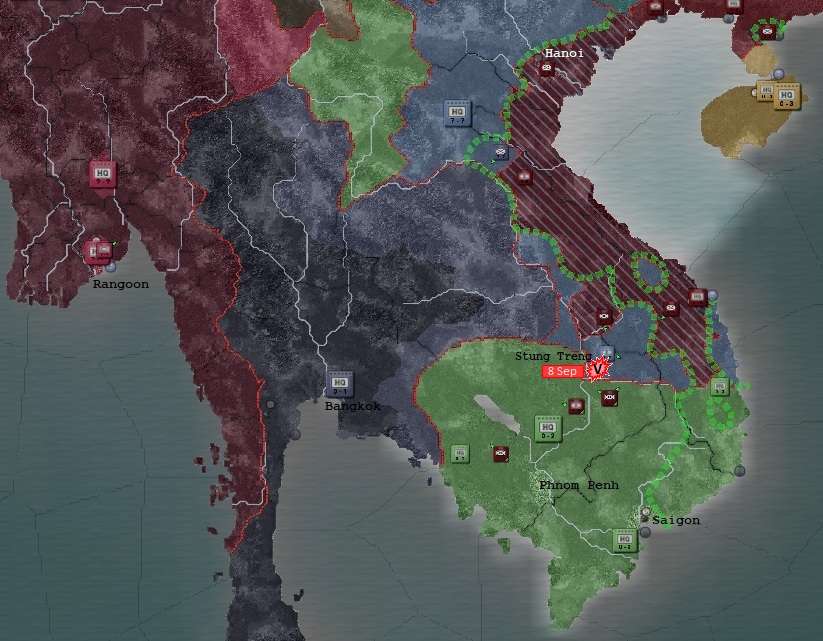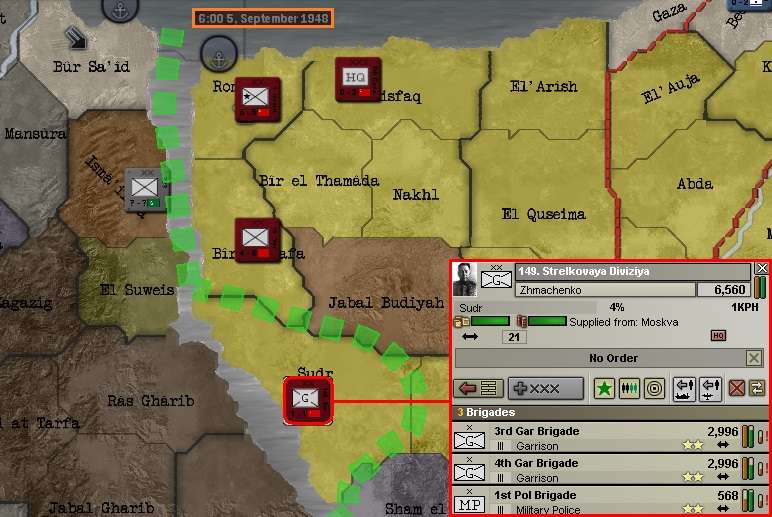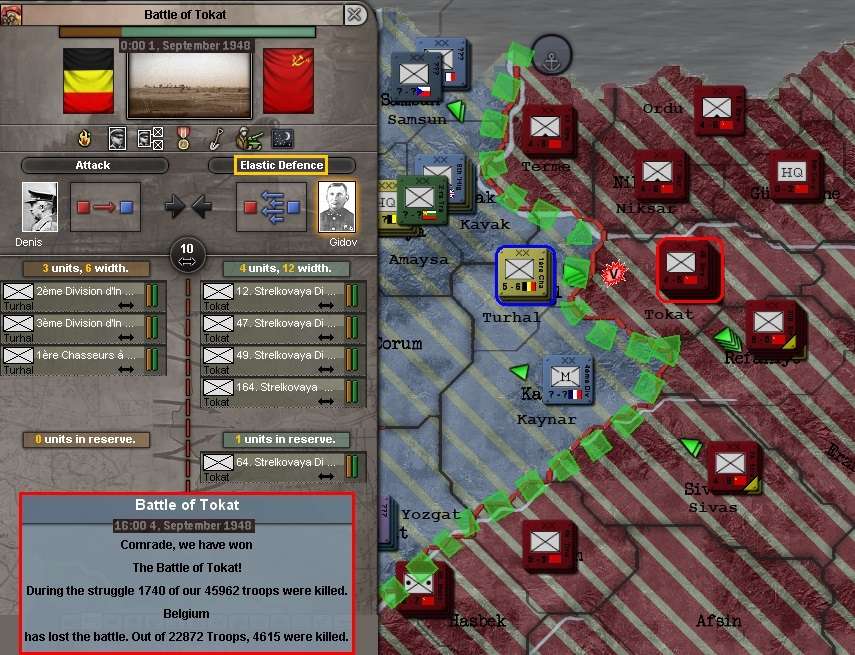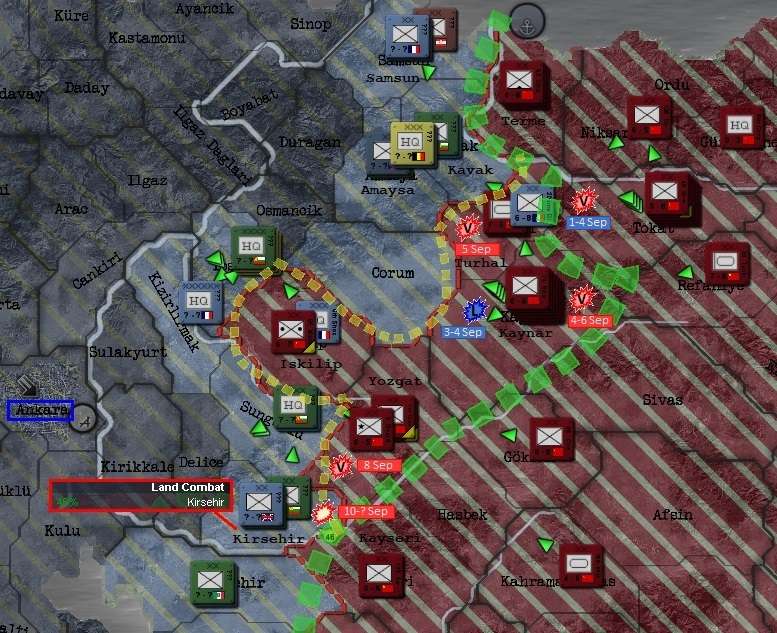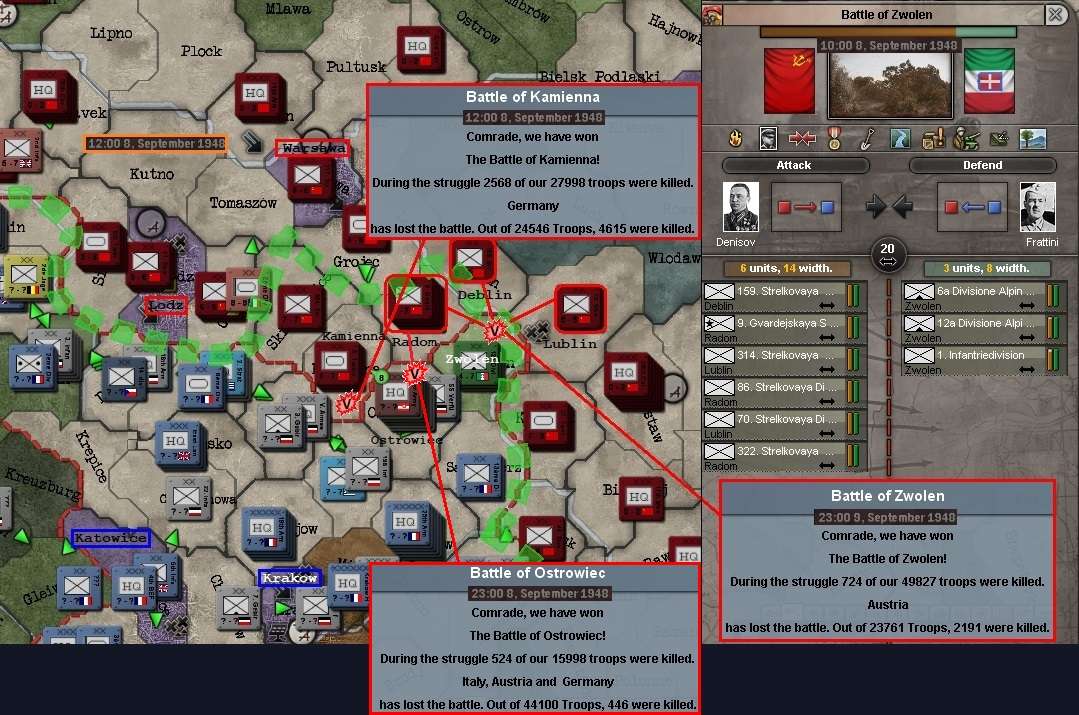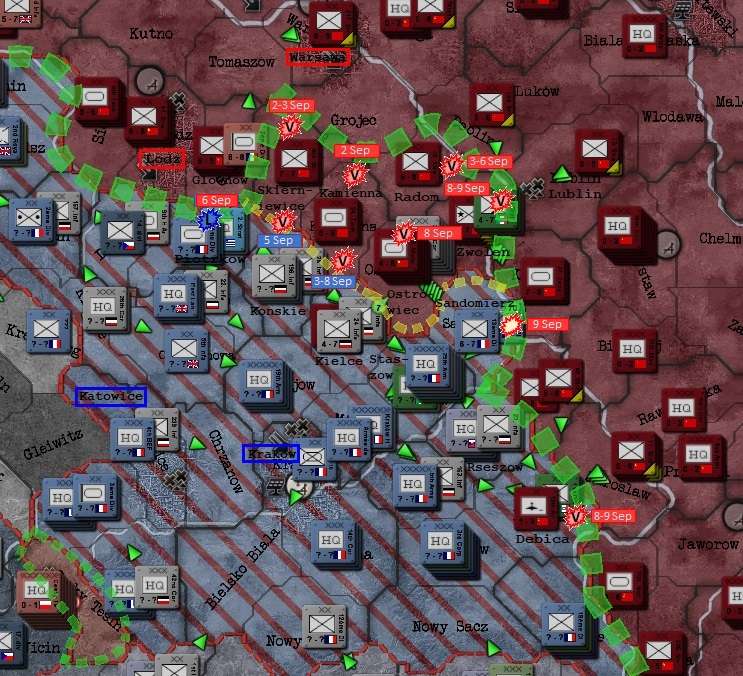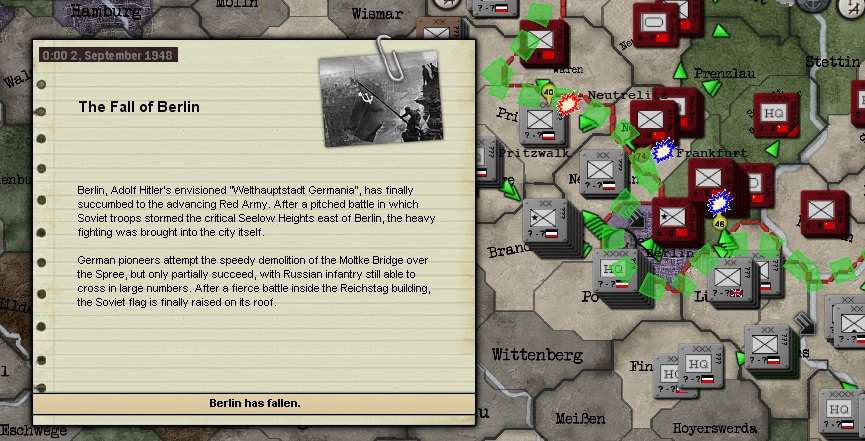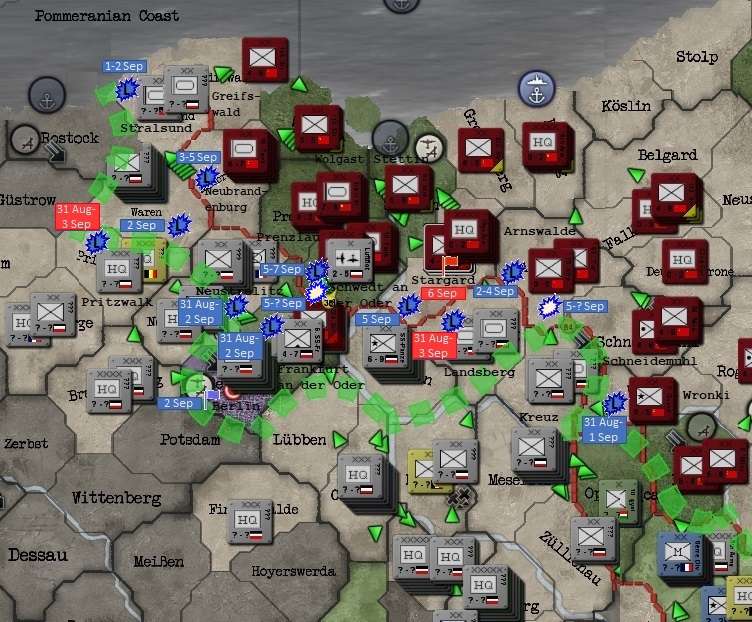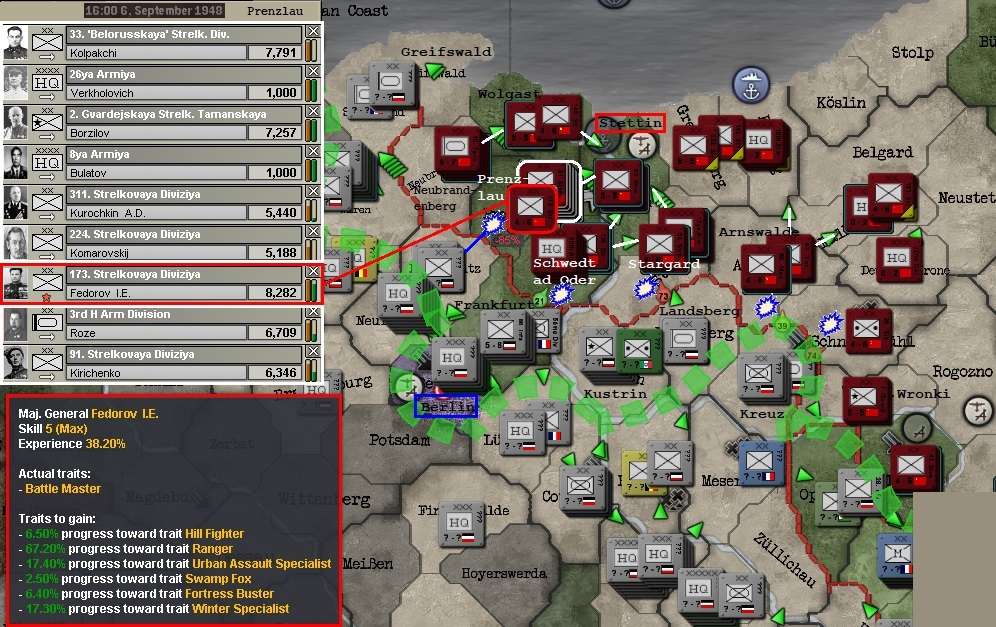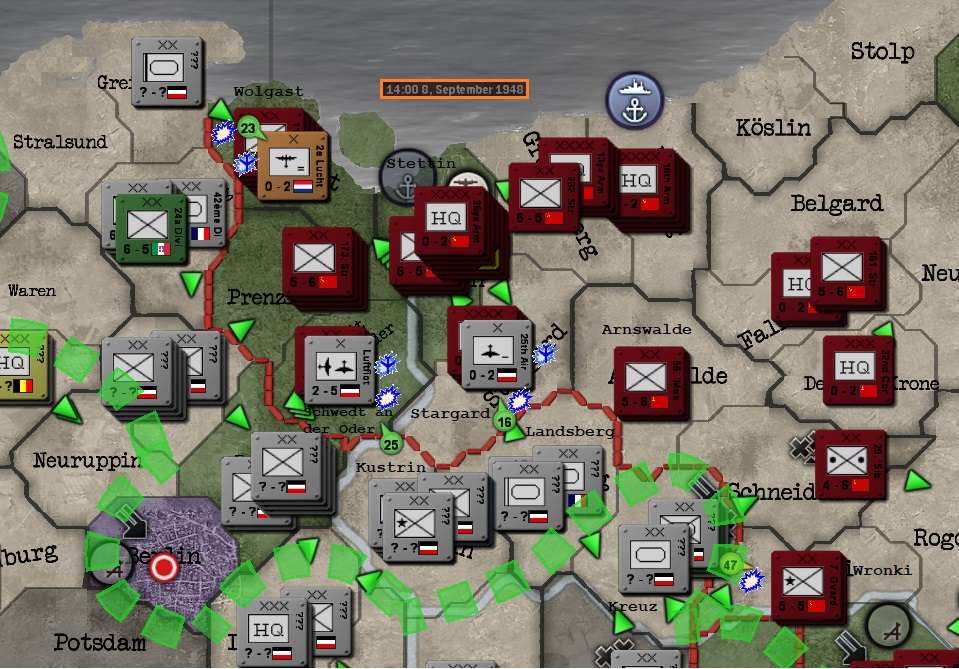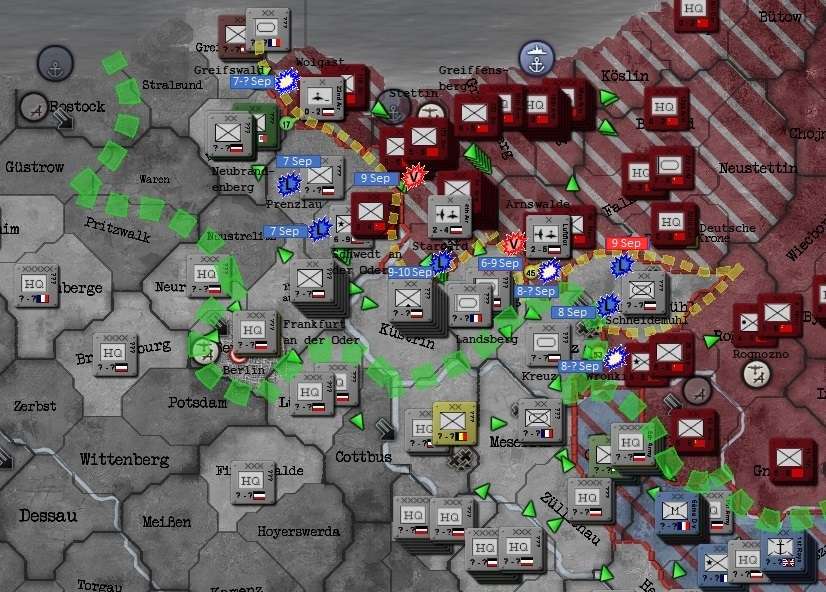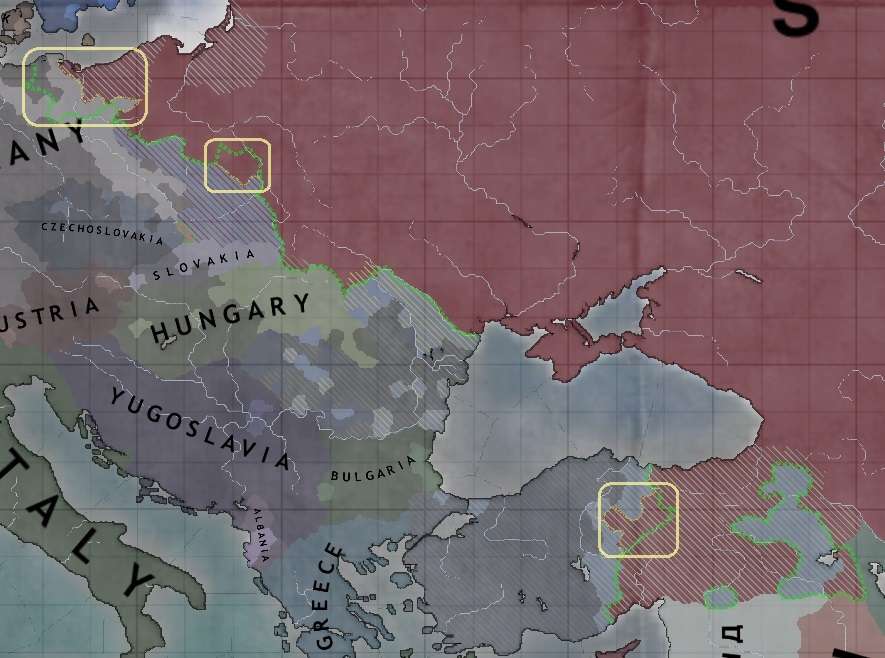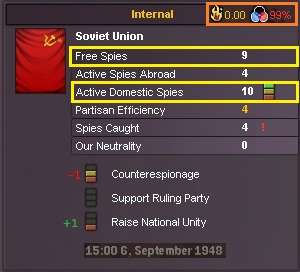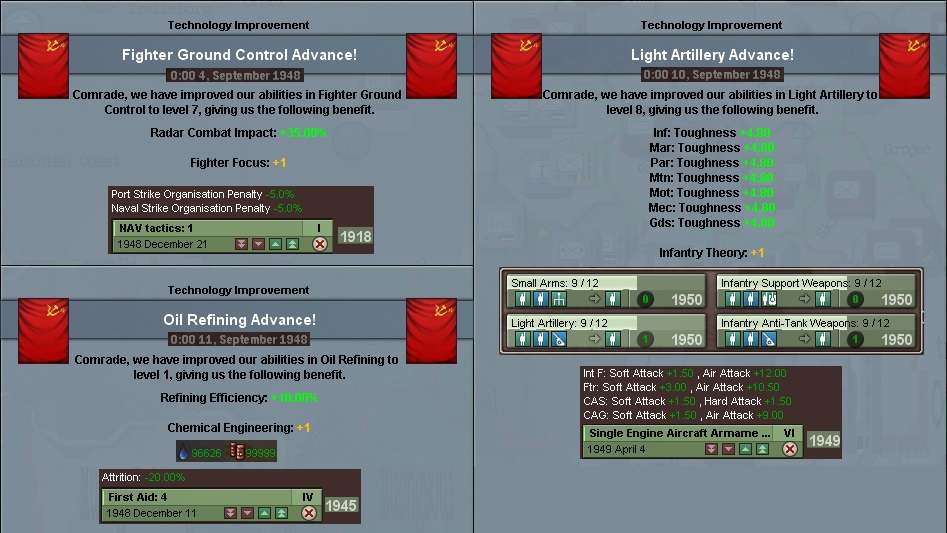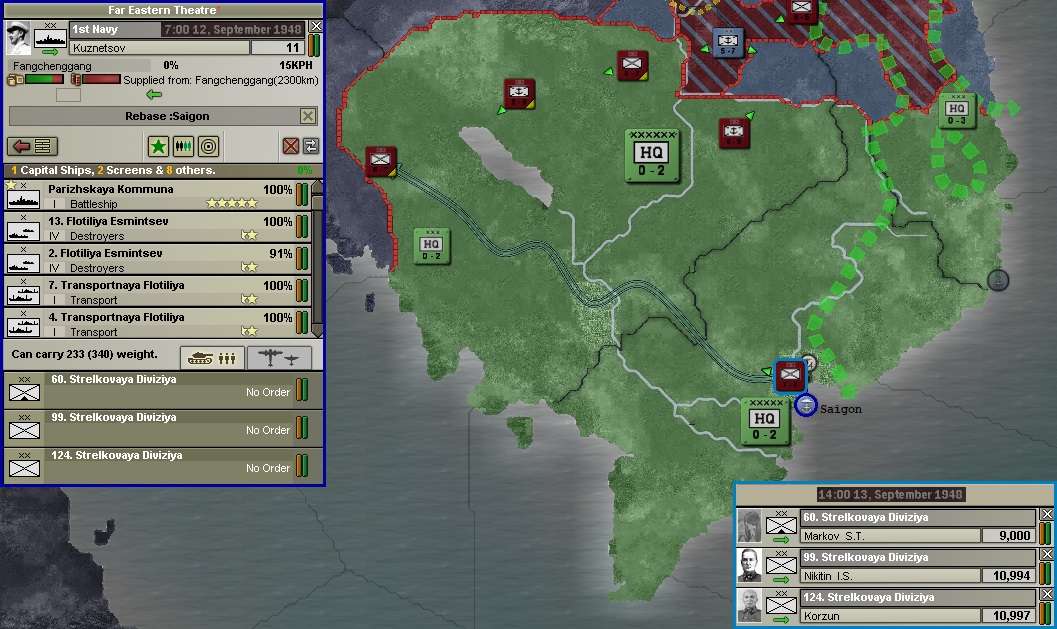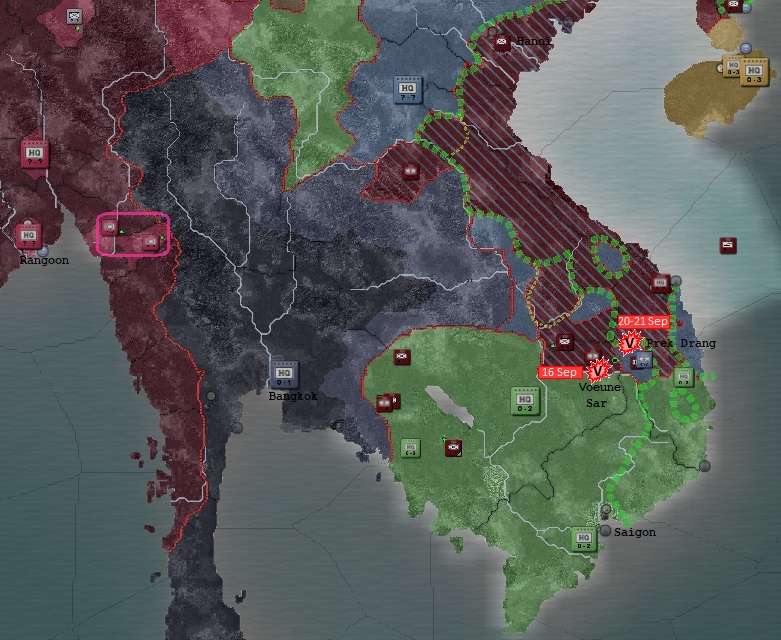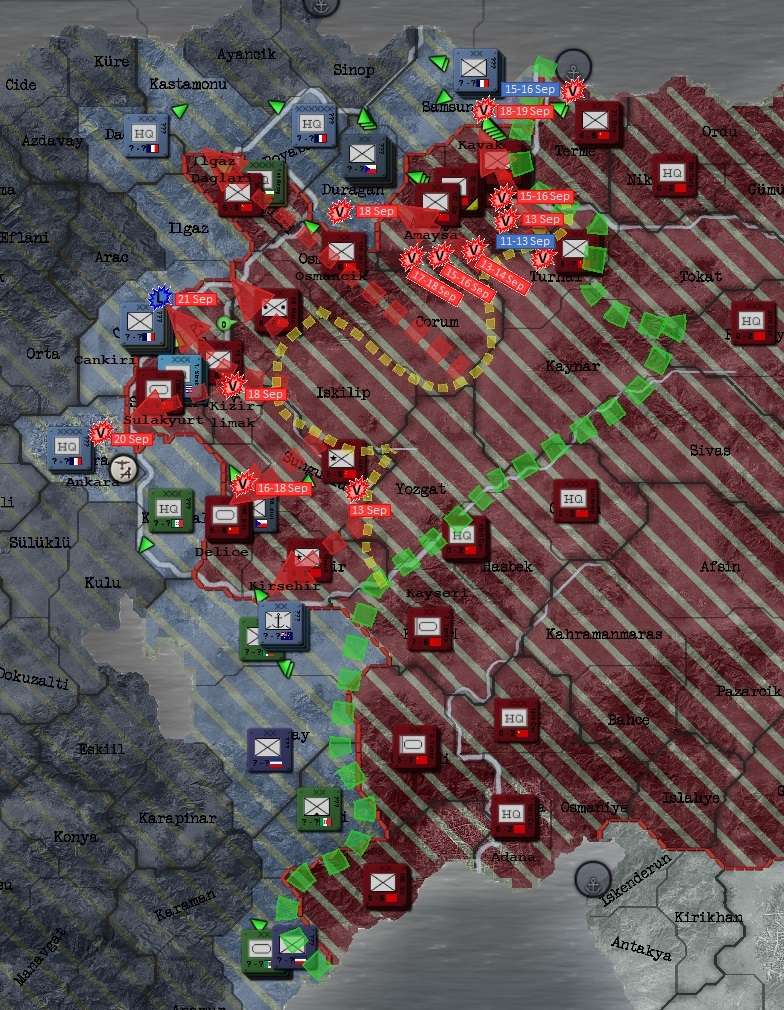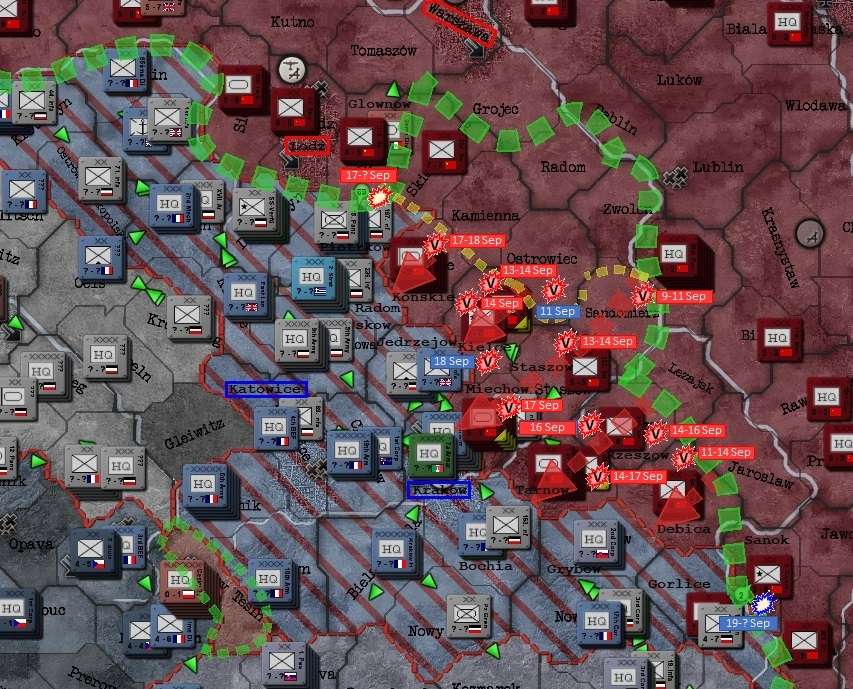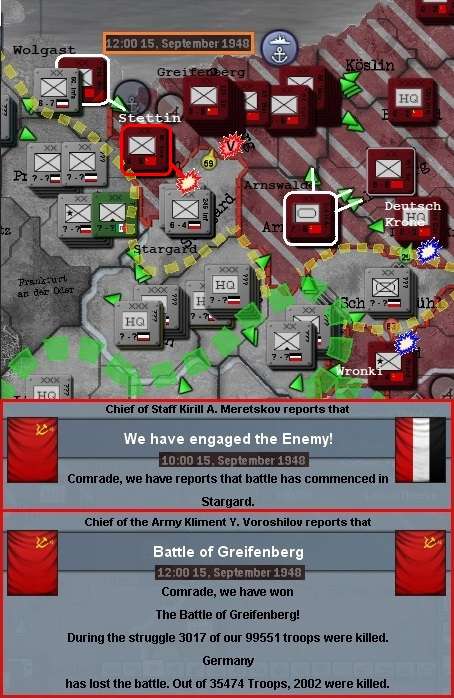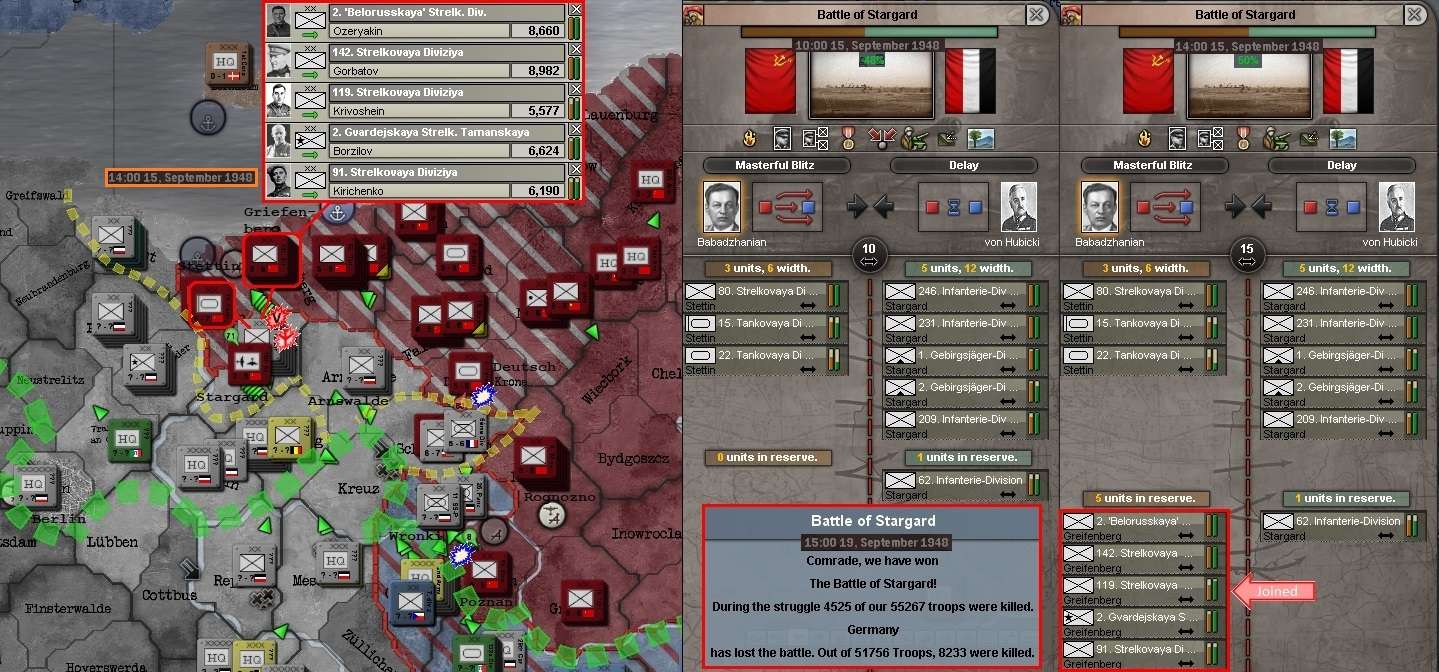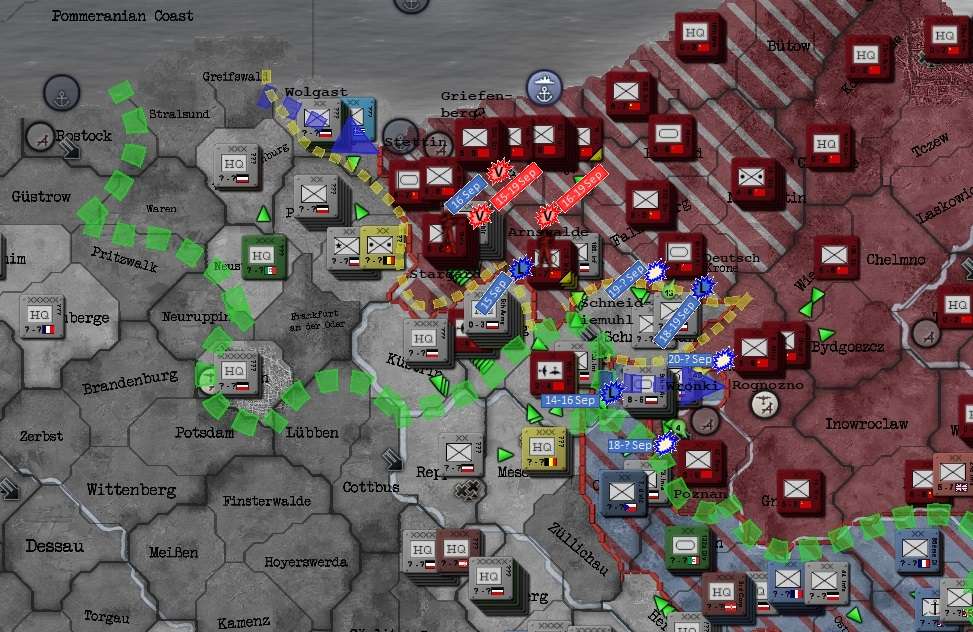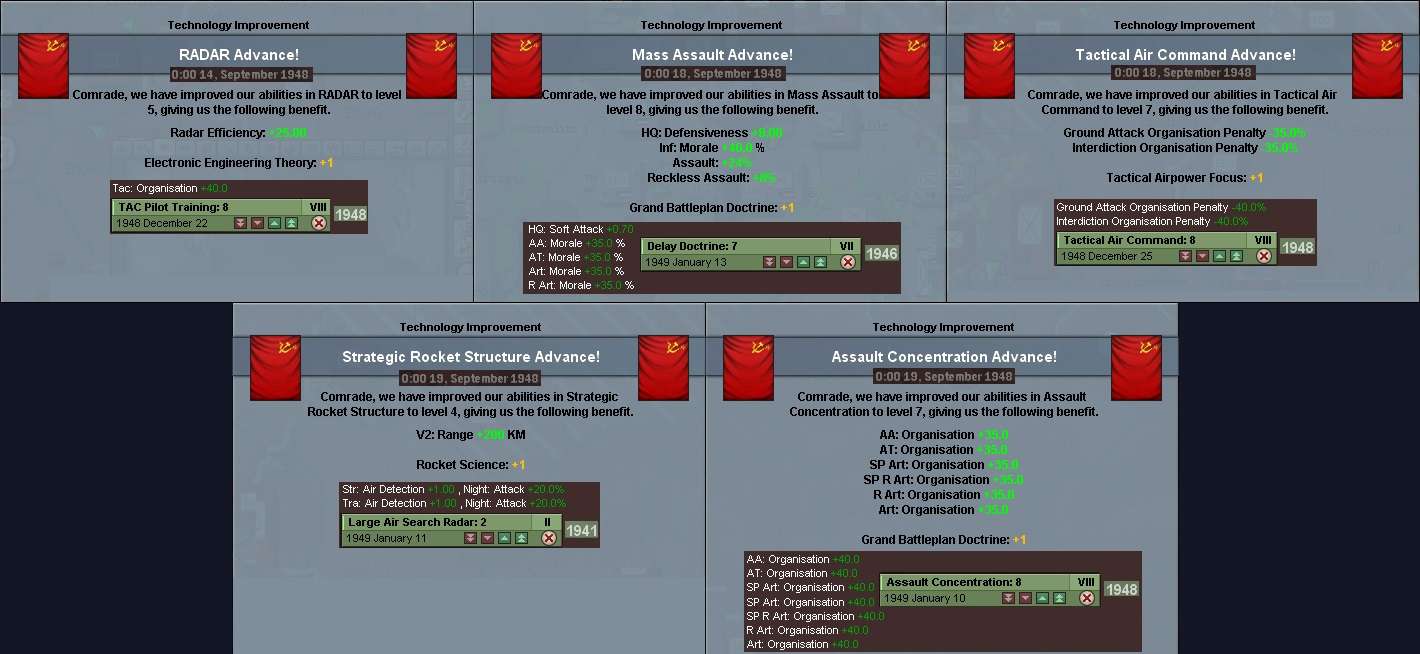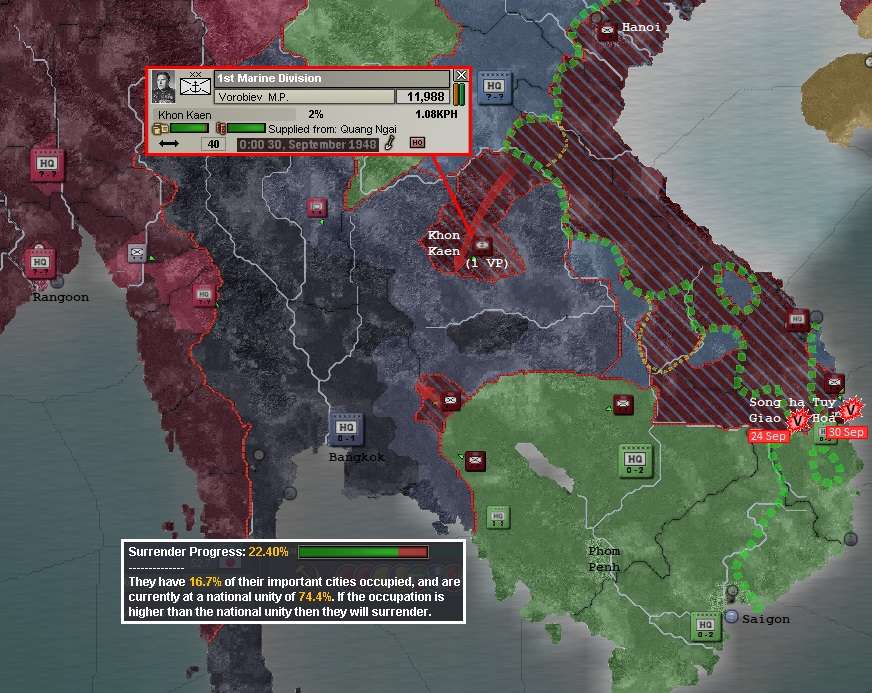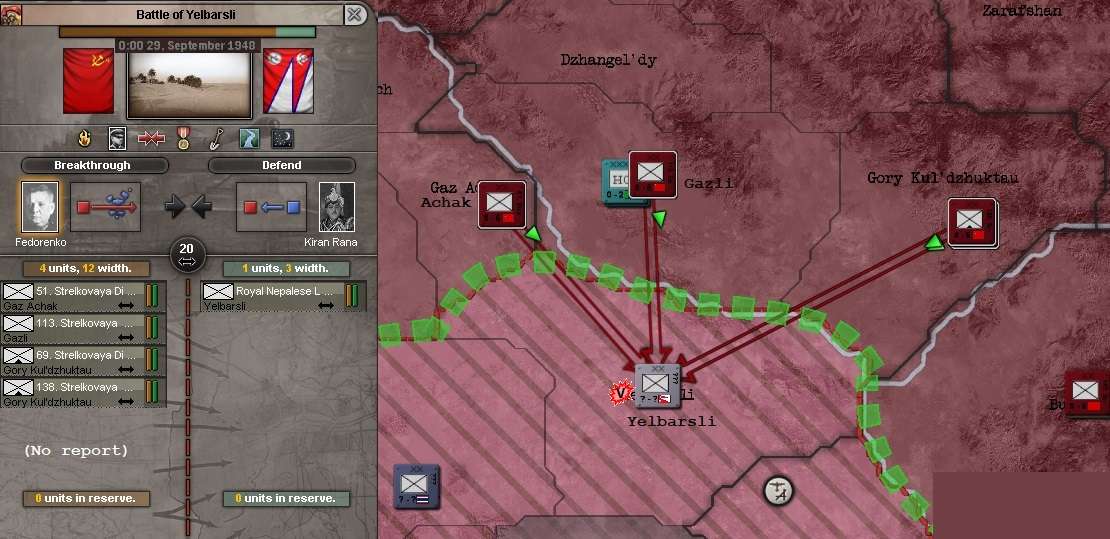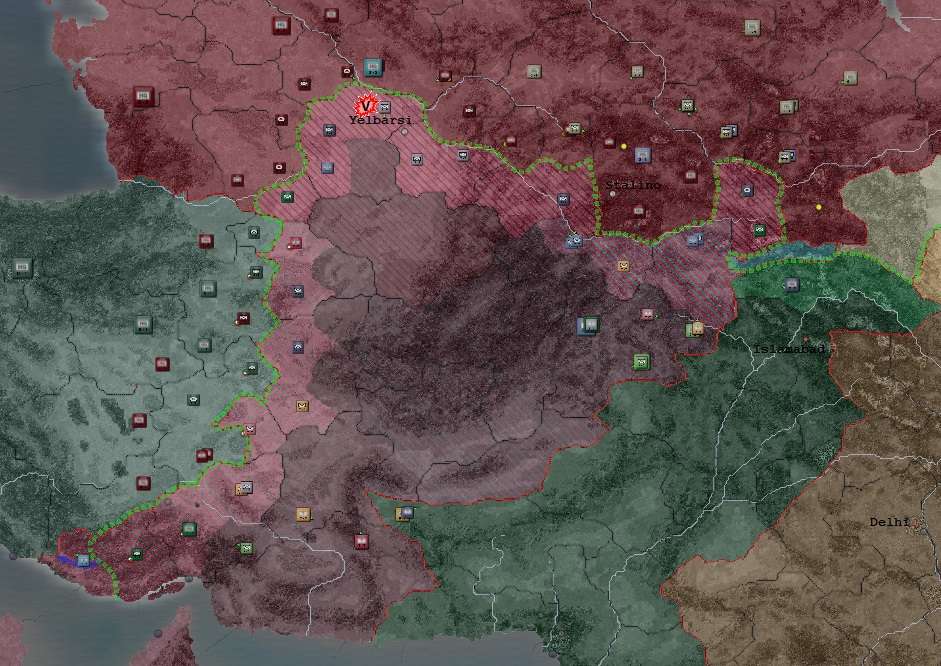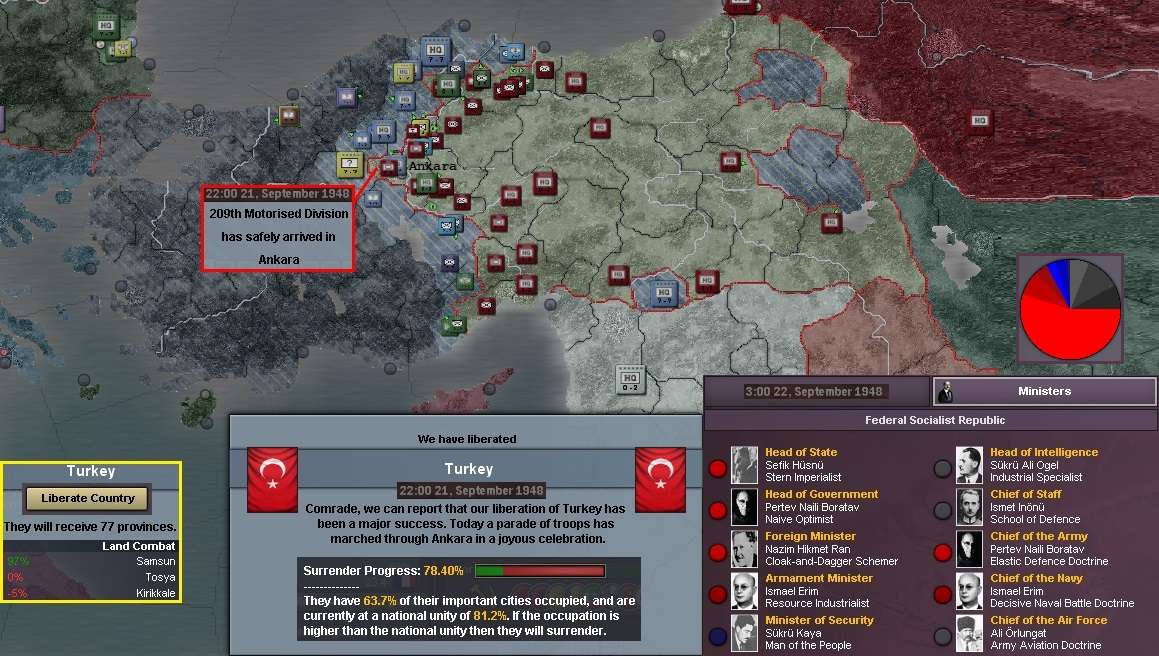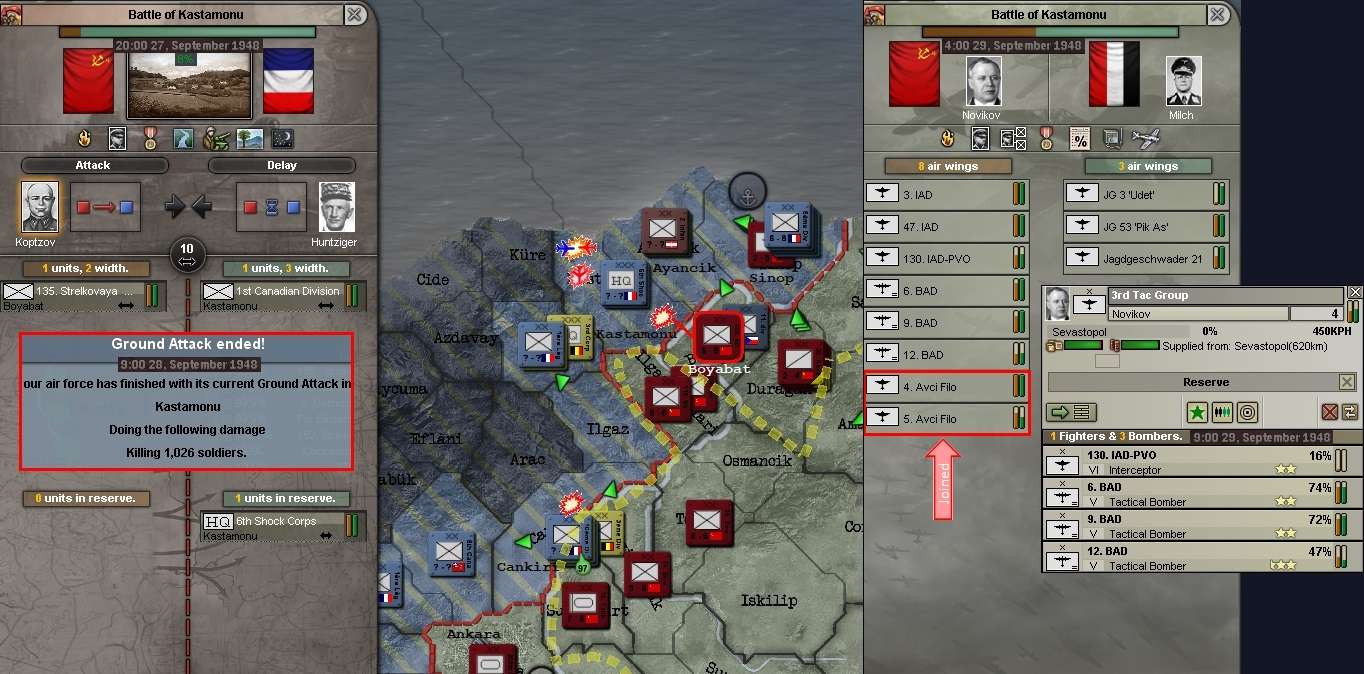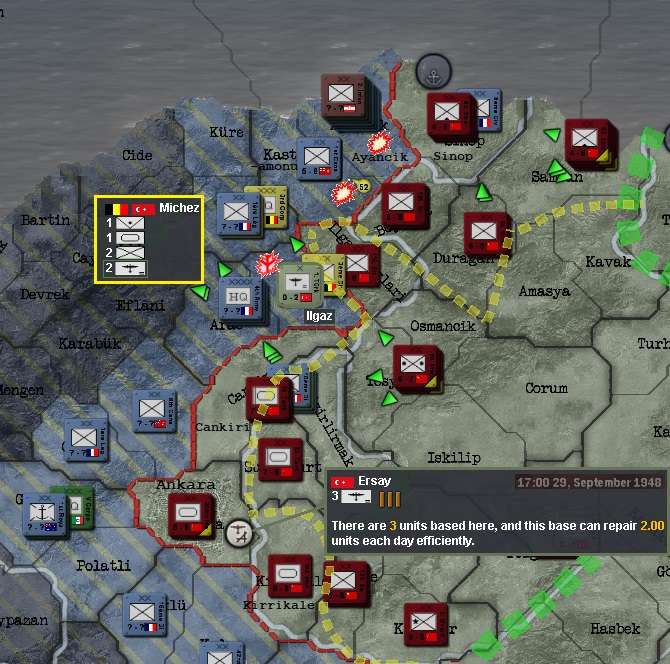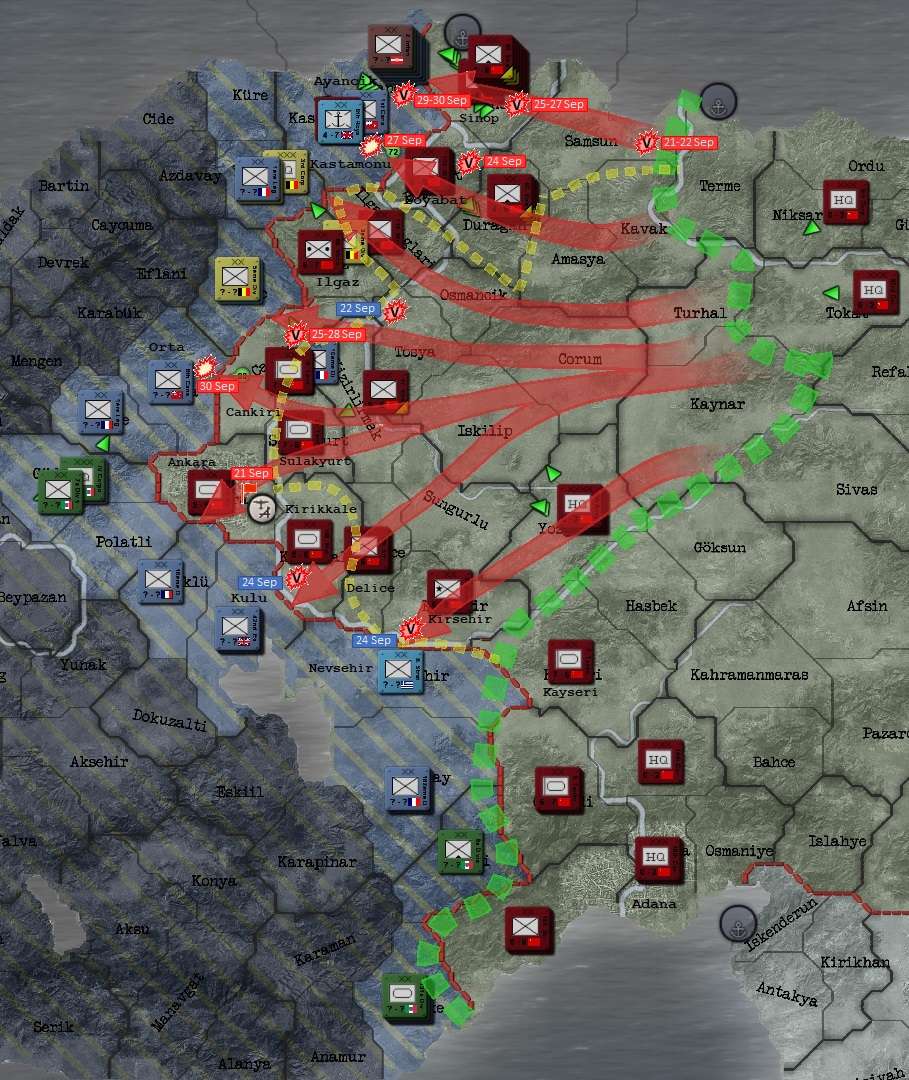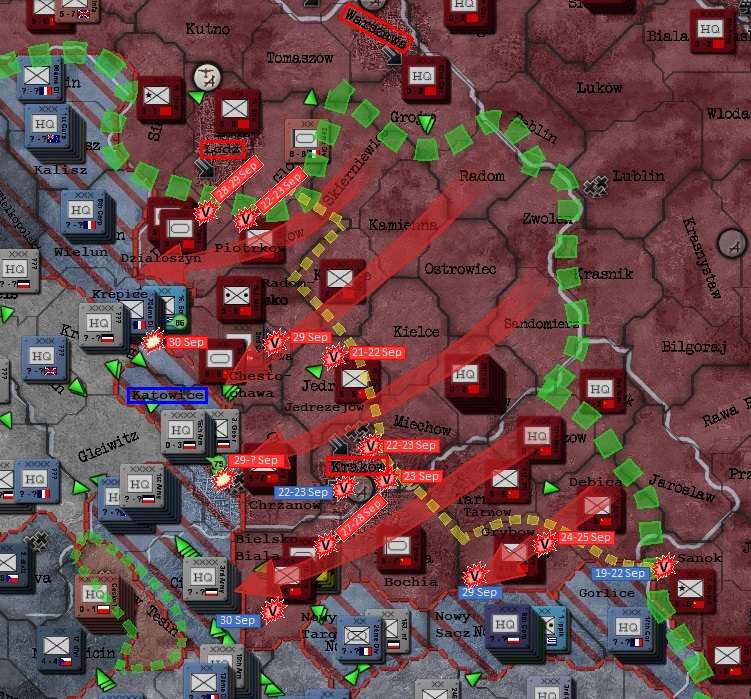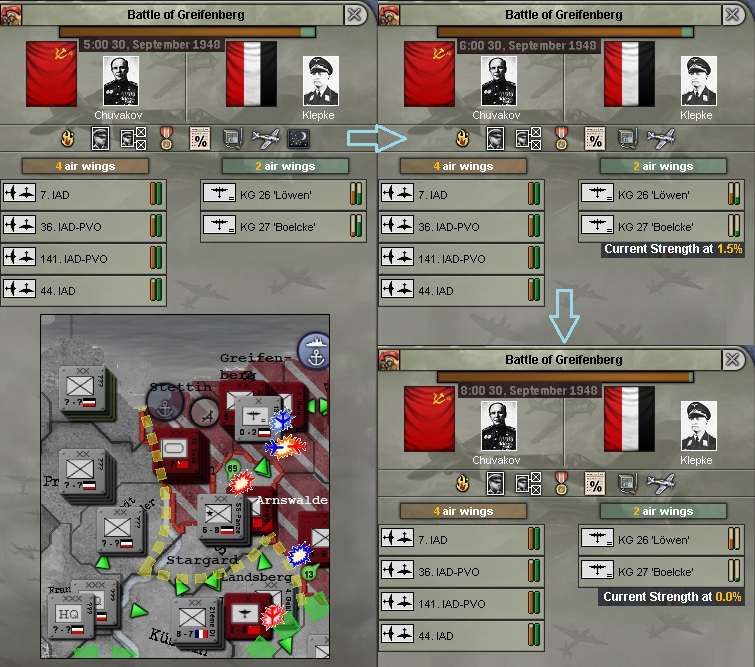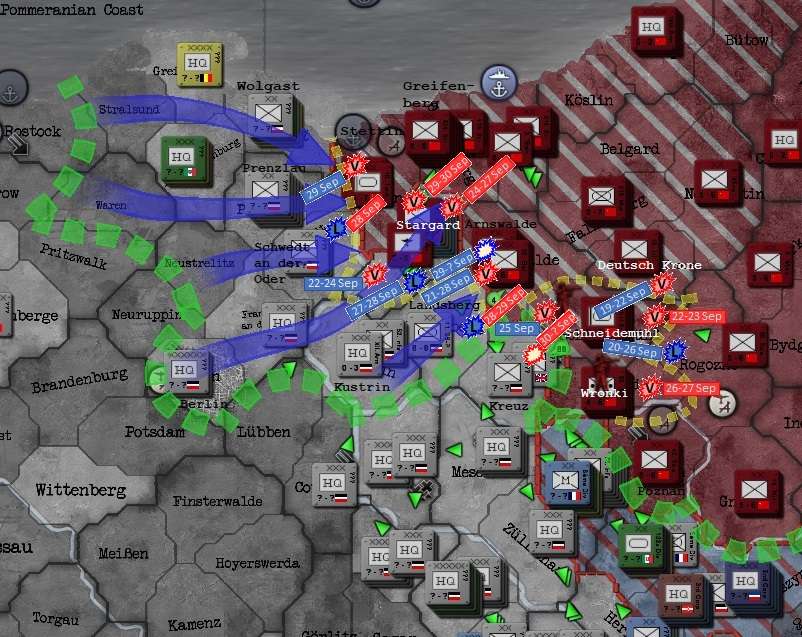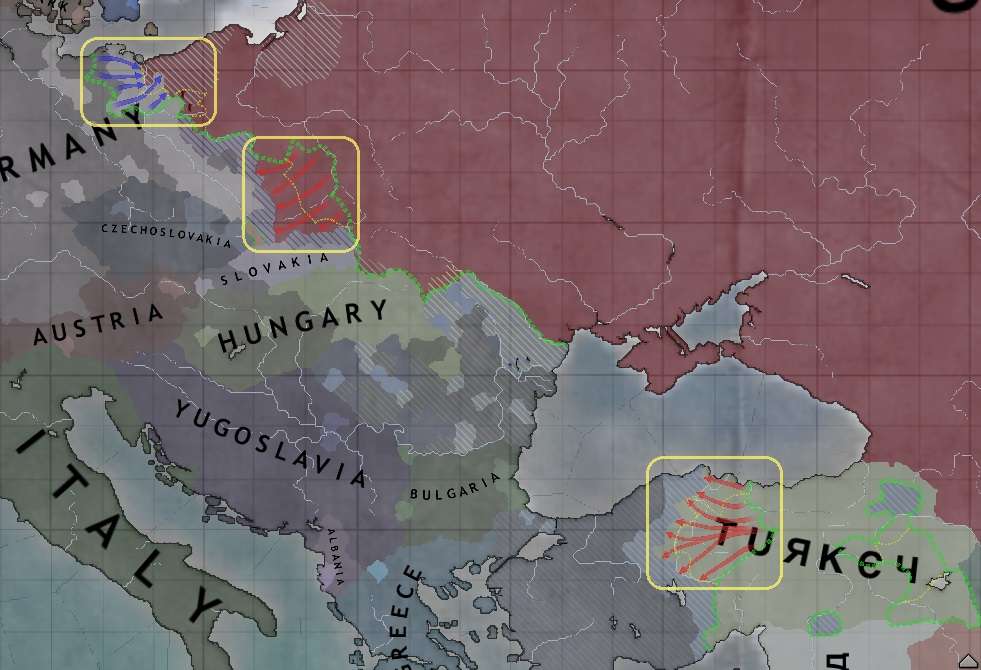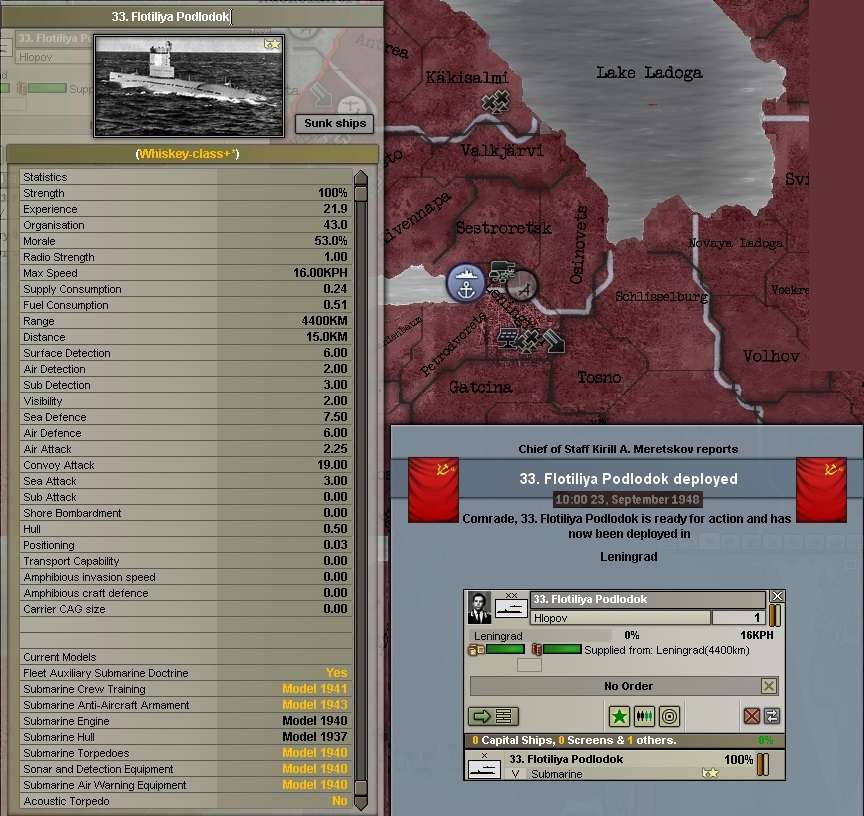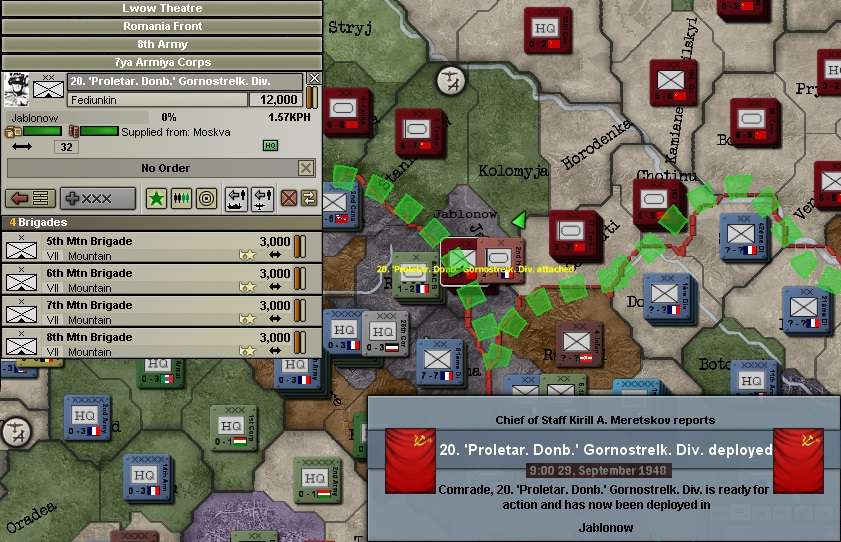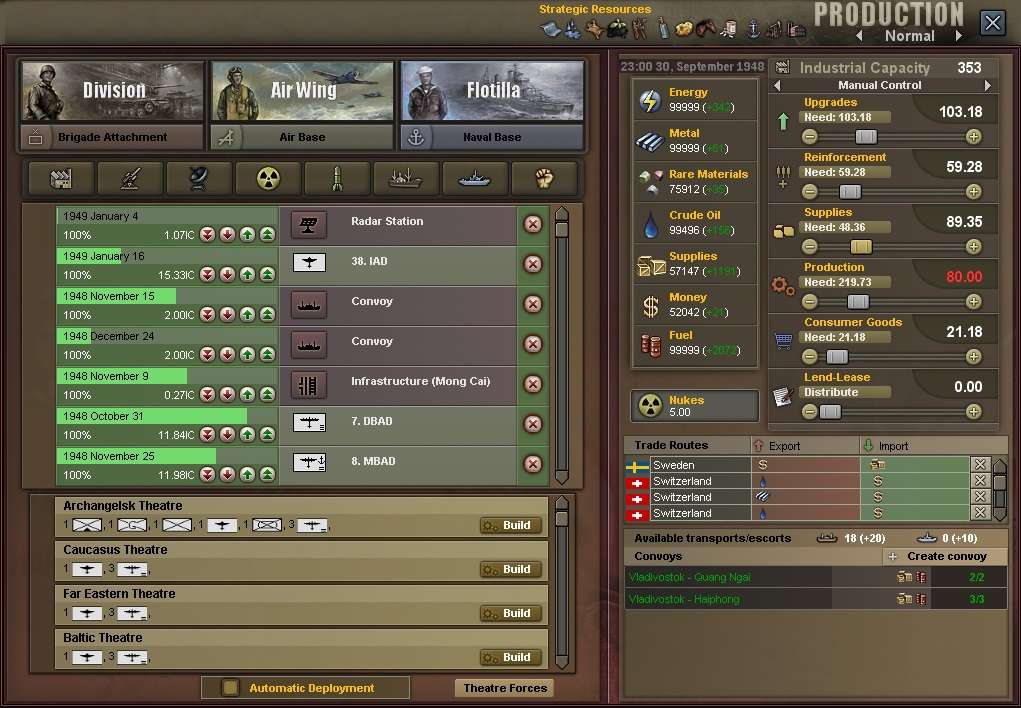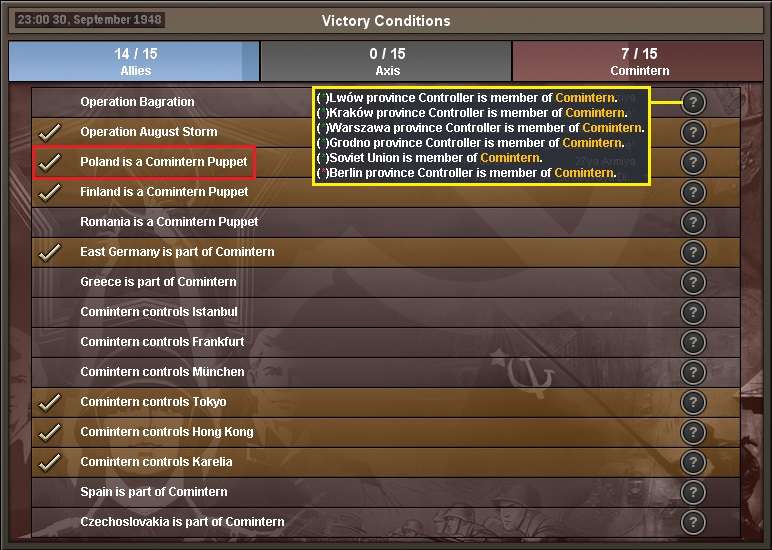Chapter 52: 11 to 20 September 1948
Note: This is the second chapter from the completed session for September. There were no events worthy of mention in either the Central Asia or Middle East theatres in this ten day reporting period.
******
1. East Asia and Indo-China
A last foray by the British 8th CAG was intercepted by two VVS INT wings over Ban Napè at midday on 11 September. They were defeated and probably destroyed within an hour. That afternoon, ships (1 x DD, 2 x TP) undergoing repair in the now overcrowded Japanese port of Haikou were sent to Fangchenggang in Soviet-controlled southern China. The main fleet (1 x BB, 1 x DD 1 x LS, 5 x TP) simultaneously made the longer and more dangerous the run to Fangchenggang from Quang Ngai.
The 1st Navy made it to Fangchenggang on the morning of the 12th and immediately picked up three divisions, ferrying them down to Saigon by 1400hr on the 13th. Those division began a strategic redeployment (SR) to the Thai border as soon as they arrived. The fleet headed up to rebase in Vladivostok.
324 SD had finished its earlier SR to the Thai border at 0200hr on the 13th, but had a 56 hour wait to reorganise after the trip before it could cross the border. Pol Pot’s Indo-China announced its mobilisation that afternoon, but would be bound by a truce with the Allies for a few years yet.
324 SD began to cross the Thai border at 1700hr on 15 September. It would be a slow progress through jungle terrain that the Red Army still did not have specialised equipment for (currently being researched).
A skirmish was fought against the 3rd Royal Marines in southern French Indo-China at Voeune Sar on the afternoon of the 16th as they were harried by Soviet divisions in a prolonged mopping up operation (Soviets 81, British 145 killed).
The combined Red Banner Pacific Fleet was split again after it reached Vladivostok at midday on 17 September to allow remaining repairs for some destroyers and transports to be completed, while the main fleet remained on standby for tasking.
By 1600hr on 18 September, the 2nd Soviet Marine Div had arrived on the Thai border earlier, but awaited fuel before it could advance. 235 SD had just arrived, but needed the 56 hour post-travel reorganisation period to end before
it could advance.
Another skirmish was fought against the 3rd RM Div at Prék Drang (Soviets 69, British 159 killed) late on the 20th, as they were pursued east along the border between southern and northern Vietnam.
Situation in Indo-China as at 2300hr on 20 September 1948.
******
2. Turkey
The Allies counter-attacked the recently regained Turhal at 0700hr on 11 September but the Soviets would record a major defensive victory at midday on the 13th (Soviets 519/41,994; Allies 2,454/17,441 killed).
Two Greek TAC wings tried to bomb Soviet troops in Sungurlu (then under Allied attack) early on 12 September, but were intercepted by VVS fighters out of Batumi. This was followed by a significant Soviet victory in an attack on Kirsehir at 1900hr that evening (Soviets 876/24,987; Allies 1,790/25,980 killed).
The defence of Sungurlu was won on the afternoon of the 13th (Soviets 90, Allies 512 killed), as was another attack on Kirsehir against a recently arrived and now badly mauled Bulgarian division (Soviets 52, Bulgarians 1,099 killed). As those battle were won, a new probe on Kavak quickly overran the exhausted defenders within a few hours.
An attack was also made on Amaysa that evening, the Soviets winning at 1400hr on the 14th (Soviets 244, Allies 254 killed). Another more serious attack was required on Kavak (1300 hr to midnight on 15 September), the Soviets winning again (Soviets 169, Allies 458 killed). The Soviet counter-offensive was building up momentum.
Victories were then won in Terme (defence; 15-16 September; Soviets 40, Allies 1,244 killed), in Amaysa again (attack; 15-16 September; Soviets 125, Allies 802 killed), in the centre at Delice (attack; 16-18 September; Soviets 388/25,766, Allies 1,900/34,136 killed) and then in defence of Amaysa after it was taken on 17 September (18 September; Soviets 278, Allies 164 killed).
A new attack along the coast on Samsun was then quickly won early on 19 September (Soviets 33, Allies 185 killed). Then on 20 September attacks were won at Kizirlirmak (centre; Soviets 157, Allies 1,336 killed) and Duragan in the north (Soviets 352, Allies 253 killed).
Air attacks by VVS TAC based in Sevastopol had kept up regularly during the period, often causing heavy Allied casualties: for example, a single raid on Nevsehir on the afternoon of 20 September killed 820 Allied troops.
The Soviet drive towards Ankara made it to the neighbouring province of Sulakyurt unopposed at 2100hr on the 20th. 209 MRD was attacking the Turkish capital an hour later, finding only HQ units in occupation and winning a quick and bloodless victory. They hoped they could move quickly enough to retake it before Allies reinforcements could arrive. At 0100hr on the 21st, a cross-river probe on Cankiri (to the north of Ankara) was quickly called off when it was realised how strongly it was being held (Soviets 21/7,998; Allies 1/32,037 killed).
Situation in Turkey as at 0100hr on 21 September 1948. The yellow dotted line is the front as at 10 September, with dashed red arrows showing gains made in the ten days to 20 September.
******
3. Poland
A two-division Soviet attack begun against an under-strength French division in Sandomierz on the afternoon of 9 September was eventually won at 0600hr on the 11th (Soviets 187, Allies 405 killed).
While the Soviets remained largely on the offensive in central Poland, the Allies were still mounting local counter-attacks. A German attack on Ostrowiec was heavily defeated at 0700hr on 11 September (Soviets 180, Allies 1,332 killed). Another major Allied attack started in Debica that morning and saw the Red Army victorious by the afternoon of the 14th (Soviets 1,936/42,994; Allies 3,276) after more than three days of fierce fighting.
Then the Germans attacked Illichivsk on the Romanian border near Odessa with three divisions on the evening of the 11th, including mechanised and heavy panzer troops, against three dug-in Soviet divisions
[-26% initial progress], an attack that would be maintained for some days
[alas, there would be no after-battle report for that one, but the casualties must have been prodigious].
Successful major Soviet attacks on Staszów (13-14 September; Soviets 497/42,661, Allies 1,553/44,532 killed) and Kielce (13-14 September; Soviets 158/43,993, Allies 1,659/31,448 killed) kept the momentum going in Poland. A determined Allied counter attack on Staszów after it was occupied (14-16 September; Soviets 207/33,294, Allies 1,613/17,640 killed) was beaten off. Another attack was required on Kielce when the Germans reinforced there before it could be taken (0900-1800 hr 14 September; Soviets 72, Allies 1,476 killed).
More large attacks followed, with the Soviets winning in Tarnów (14-17 September; Soviets 452/45,400, Allies 1,255/28,250 killed) and then in a short but vicious action in Rseszow (0400-1400hr 16 September; Soviets 2,321/58,355, Allies 3,530/26,384 killed).
At 2200hr on 15 September, the German cross-river attack on Illichivsk continued, though the attackers were becoming badly worn out. They called in air support from the Luftwaffe, which was intercepted from Brzesc Litweski in a fierce dogfight (VVS 3 x INT, Luftwaffe 3 x INT, 2 x CAS).
Another crushing attacking victory came at Konskie (17-18 September; Soviets 217/50,986, Allies 2,243/12,702 killed). Meanwhile, a new Red Army attack on Miechow started at 1500hr on 17 September met with stiffer Allied resistance
[52% initial progress] and would be won on the afternoon of 20 September ended (no battle report recorded, but 30,287 Soviet troops in four divisions had attacked 42,256 Allied men in five).
Around the same time, a major Soviet attack on Piotrkow at 1700hr on the 17th met with similarly determined resistance
[60%] and it would still be going as the reporting period ended (44,990 Soviet troops in five divisions against 27,924 Allied men in four divisions). Kielce was taken on the morning of the 18th and an Allied counter-attack defeated by 1100hr that morning (Soviets 133, Allies 1,051 killed).
All the while, one VVS TAC group and two CAS groups were in almost constant action along the Polish front, supporting attacks or providing defensive air support. For example, single night time raids 20 September on Piotrkow (393), Miechow (543) and Gorlice (357) caused significant Allied casualties and these figures were often significantly higher during the day. They were rarely if ever intercepted by Allied fighters during this reporting period.
Situation in Poland as at 0100hr on 21 September 1948. The previous Soviet gains were being extended towards the intermediate objective of Krakow, but the fighting remained hard.
******
4. Germany
Unlike in Turkey and Poland, the momentum in Germany remained with the Allies. The ongoing defence of Arnswalde was lost at 0200hr on 11 September even though the Allies were heavily outnumbered (Soviets 1,504/26,599; Germany 821/7,755 killed).
Allied air attacks had also resumed. To assist with blunting them, the four VVS M/R wings that had been based in Tel Aviv were methodically ‘reserve hopped’ to Königsberg so they were fully organised and ready to fight at 0700hr on the 11th. They were split into two groups of two, to be used as required to begin pushing back harder against Allied sorties. Concurrently, the Allied air base at Breslau (repair capacity 8.11) was identified as having 13 German and French wings operating out of it. A Soviet rocket strike had reduced its repair and AA facilities to almost zero by 0900hr that morning.
Dogfights soon followed on 11-12 September:
- over Rogozno (3 x Soviet INT v 3 x German INT), where one German wing was almost destroyed and the other two heavily damaged, with one VVS wing badly damaged and another disorganised;
- in Wolgast (4 x Soviet M/R v 2 x German CAS and 2 x INT), where a CAS wing was very heavily damaged and the Soviets almost unscathed;
- then again over Wolgast ( 4 x Soviet M/R v 2 x Dutch TAC and 2 x German INT) where one of the Dutch wings was reduced to 0% strength and organisation.
This series of engagements seemed to set the Allied air effort back considerably.
The Germans initiated a new and larger two-division attack on Stettin
[-12%] late on 11 September as fighting continued in Wolgast
[-58%] to its north-west, where the situation was worsening. The Stettin attack would not end until 1400hr on 14 September, with Soviet victory (Soviets 366/39,464; Germans 1,890/24,299 killed). This held the Red Army in place there while behind it, the Allies threatened to encircle the key city.
Greifenberg – by then Stettin’s only remaining link to the rest of the Soviet line – came under heavy German attack from Stargard at 1600hr on 12 September, while the delaying action to the west in Wolgast continued. Arnswalde had been occupied by German panzers, though a Soviet counter-attack from the east looked like evicting them again. The fighting around Greifenberg, Stargard and Arnswalde would prove pivotal and fierce during this period, with the entire Soviet position in the north hanging in the balance as they dug in to try to hold Stettin.
Four hours later, a large VVS raid began on Stargard, trying to disrupt the German attack that threatened Greifenberg, with three TAC wings pounding the enemy. Two Luftwaffe INT wings would try to intercept them over Stargard, but were ambushed by the four VVS M/R wings from Königsberg before they could attack the bombers, the Germans suffering heavy damage in the process and allowing the VVS bombing runs to continue. In the period from 2300hr on 12 September to 0700hr on the 14th alone, four of these raids would kill 277 (night time, contested), 777, 1,028 and then 945 German attackers.
By 0200hr on 14 September, three Soviet divisions had been routed or withdrawn from Griefenberg, but four more had taken their place in reserve, while the Germans had brought in one more division in reserve themselves. Despite the VVS support, the battle remained in the enemy’s favour, but the Soviets’ defensive tactics had at least improved.
By the morning of 13 September, the advantage in Wolgast had swung further in the Allies’ favour
[-77%]. Fearing being cut off, after strong resistance the last remaining division there began evacuating to Stettin at 1000hr (Soviets 2,217/50,748; Allies 3,489/32,641 killed). At that time, Stettin was holding strongly but Greifenberg was in trouble
[-73%]: a large encirclement still seemed possible.
The Soviet 3rd HArm Div briefly retook Arnswalde at 1700hr on 13 September after evicting their German counterparts. But they were badly disorganised after their exertions and an hour later they were themselves counter-attacked by a fresh German infantry division and forced to retreat by 1900hr (Soviets 17/6,166; Germans 38/7,775 killed).
Their place was taken at 0100hr on 14 September by the under-strength 14 Tank Div, but they found themselves under attack and badly outnumbered by four fresh German infantry divisions. They held out until 1400hr that afternoon, but withdrew as casualties mounted and their position became hopeless (Soviets 733/4,999; Germans 257/33,662 killed). Meanwhile, to the south-east in Wronki, a defensive victory was won by the Soviets at 0300hr on the 14th (Soviets 1,932, Allies 1,944 killed).
Situation in Germany as at 0300hr on 14 September 1948. The contest had remained fierce along the line from Wronki through to Wolgast during the first three days of the reporting period, with both sides claiming some victories and Arnswalde changing hands from one side to the other and back. The Germans remained on the attack at that time in Stettin, Greifenberg, Deutsch Krone and Rognozno.
******
The victory in Wronki was soon forgotten as the Allies attacked again at 0700hr on 14 September with four fresh divisions (three German and one Hungarian). Despite one fresh Soviet division having recently arrived, 7 Guards Div was exhausted from the previous hard battle and the defence could not be sustained. The retreated was ordered at 1400hr that afternoon (Soviets 1,838/15,228; Allies 422/31,353 killed). This now threatened the last remaining Soviet bridgehead over the Vistula in Poznan, to its immediate south.
Another late-arriving Soviet tank division in Arnswalde (having participated in the earlier successful Soviet attack) also came under heavy pressure when it arrived and did not attempt to hold, quickly pulling back (Soviets 17, Allies 13 killed). Arnswalde would be left for the Allies to reoccupy for the time being as the Soviet defensive effort remained concentrated on saving Stettin and Greifenberg.
The Luftwaffe sent two unescorted CAS wings to strike Greifenberg at 0200hr on 15 September, but a scratch VVS fighter group (1 x INT, 2 x M/R) fought them off. Then relief came for Greifenberg (still under heavy pressure) when the defensive victory in Stettin allowed a spoiling attack to be mounted on Stargard at 1000hr.
After just two hours, the Germans broke off their attack but the Soviets would keep pushing on against Stargard, hoping to retake the crucial province even as Arnswalde was being temporarily abandoned. This was just as well, as a single German mountain division briefly attacked Greifenberg again at 2000 hr on 16 September, but soon broke off the probe (Soviets 19, Allies 29 killed).
The new concerted Soviet counter-strike to retake Arnswalde began with a heavy artillery bombardment at 2100 hr on the 16th, while the Germans mounted a strong defence with three divisions. It would take until 0600hr on 19 September, but this latest attack would prove successful (Soviets 1,796/33,684; Allies 3,467/25,975 killed). The autumn soil of the province ran red with the blood of both sides.
The savage fighting in Stargard continued on the afternoon of 17 September
[67%], with heavy VVS air support (single raids in daylight often killing over a 1,000 defenders a time). A new Allied attack by three divisions (two German and one Czech) began on Poznan on the morning of 18 September, but found progress difficult
[-9%] against two well entrenched Soviet divisions. Despite this, it would not be resolved before the end of 20 September.
The great battle for Stargard came to a head on the afternoon of 19 September. As we saw earlier, the battle had begun at 1000hr on 15 September as a spoiling attack from Stettin to relieve the imperilled defence of Greifenberg. Incessant heavy air strikes had progressively weakened the German defenders since then, but a key change had come on the afternoon of the 15th, when victory in Greifenberg had allowed five relatively fresh divisions from there to open a second flank on Stargard.
This would lead to a great Soviet victory on the afternoon of 19 September. The enormous German casualties from the ground fighting would have been exceeded by those from the heavy VVS air strikes from 15-19 September. By 1700hr, Stargard had been reoccupied in force by the five Soviets divisions from Griefenberg (all of which were somewhat disorganised by then), while those in Stettin held back and recovered as German forces (estimated to be three full corps in strength) massed in the three provinces across the river to their west.
Further east, the Allied pressure on Deutsch Krone saw the Soviets defeated there just two hours later (Soviets 540/8,010; Allies 670/7,571 killed), though a fresh Red Army division would slip in before the end of the day to renew the defence, which would continue throughout 20 September.
The Allied effort in that sector, now based out of their new positions in Wronki, was manifested in a new attack on Rogozno that began at 0300hr on 20 September and still raged as the day ended (one German heavy panzer and one Italian motorised infantry division against five Soviet infantry divisions).
Situation in Germany as at 0100hr on 21 September 1948. Net advances made by the Germans since 10 September included Wolgast in the north-west and Wronki in the south-east. In battles since the previous summary for 14 September, the Soviets had defended Greifenberg and lost but then regained Stargard and Arnswalde. The Allies remained on the attack in the south-east at Poznan and Rogozno, but their general momentum had been slowed somewhat over the last ten days, with the return of Soviet air superiority being a key factor.
Overall, the three main active fronts in the West remained a mixed bag in September so far and over the last ten days. Significant advances had been made in Poland and Turkey, but the Allies had made crucial gains in Germany, despite furious Soviet resistance. That front remained evenly poised.
5. Production, Intelligence and Research
A stockpiled radar station was deployed in Torun on 18 September, to assist with signals intelligence and forward air operations in both Germany and Poland.
The NKVD reported that a German underground resistance cell had been established in Alllenstein on 19 September.
And between 14-19 September, five Soviet research projects were completed, ranging from RADAR advances, to improved ground and air doctrine and a better rocket design to increase their range. New projects were concentrated on improving VVS radar equipment for the STRAT arm and both land and air doctrine.


